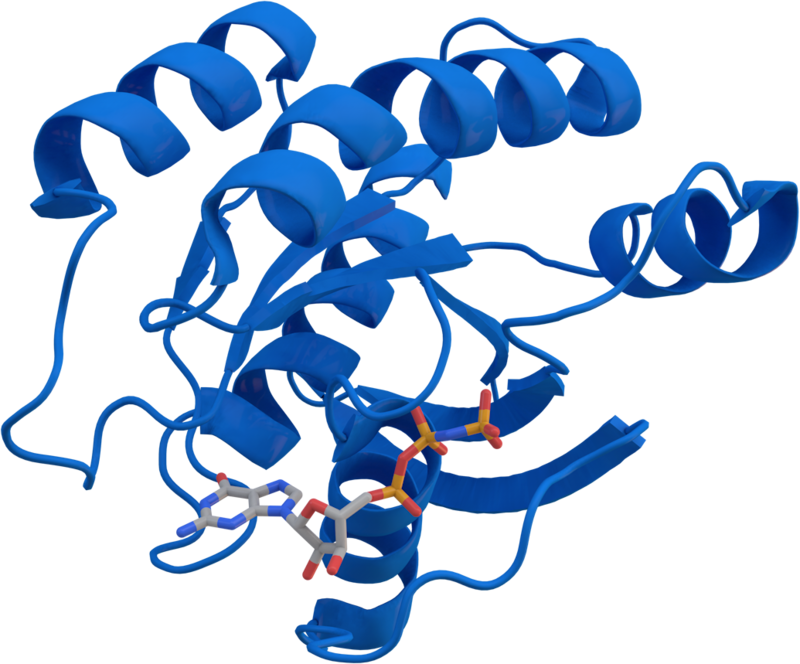
This gene, a Kirsten ras oncogene homolog from the mammalian ras gene family, encodes a protein that is a member of the small GTPase superfamily. A single amino acid substitution is responsible for an activating mutation. The transforming protein that results is implicated in various malignancies, including lung adenocarcinoma, mucinous adenoma, ductal carcinoma of the pancreas and colorectal carcinoma. Alternative splicing leads to variants encoding two isoforms that differ in the C-terminal region. [provided by RefSeq, Jul 2008]
Tumor type associations:
- Bladder
- Breast
- Cervical
- Colorectal
- Endometrial
- Esophageal
- Gastric
- Kidney
- Liver
- Lymphoma
- Melanoma
- Ovarian
- Pancreatic
- Prostate
- Involved in MAPK cascade
- Involved in positive regulation of protein phosphorylation
- Signal transduction
- Involved in Ras protein signal transduction
- Involved in positive regulation of cell population proliferation
- Located in Golgi membrane
- Located in cytoplasm
- Located in mitochondrial outer membrane
- Located in endoplasmic reticulum membrane
- Located in cytosol
- Nucleotide binding
- Enables GTPase activity
- Enables G protein activity
- Enables protein binding
- Enables GTP binding
Ras proteins bind GDP/GTP and possess intrinsic GTPase activity (PubMed:20949621). Plays an important role in the regulation of cell proliferation (PubMed:23698361, PubMed:22711838). Plays a role in promoting oncogenic events by inducing transcriptional silencing of tumor suppressor genes (TSGs) in colorectal cancer (CRC) cells in a ZNF304-dependent manner (PubMed:24623306). RASK_HUMAN,P01116
- Oculoectodermal Syndrome
- Schimmelpenning-Feuerstein-Mims Syndrome
- Cardiofaciocutaneous Syndrome 2
- Noonan Syndrome 3
- Arteriovenous Malformations Of The Brain
- Ras-Associated Autoimmune Leukoproliferative Disorder
- Gastric Cancer
- Pancreatic Cancer
- Lung Cancer
- Juvenile Myelomonocytic Leukemia
- Bladder Cancer
- Noonan Syndrome 1
- Cardiofaciocutaneous Syndrome 1
- Leukemia, Acute Myeloid
- Lung Squamous Cell Carcinoma
- Encephalocraniocutaneous Lipomatosis
- Plasma Cell Neoplasm
- Pilocytic Astrocytoma
- Diffuse Gastric And Lobular Breast Cancer Syndrome
- Breast Cancer
- Thyroid Gland Cancer
- Pseudo-Turner Syndrome
- Thyroid Tumor
- Gallbladder Cancer
KRAS Localizations – Subcellular Localization Database
This gene, a Kirsten ras oncogene homolog from the mammalian ras gene family, encodes a protein that is a member of the small GTPase superfamily. A single amino acid substitution is responsible for an activating mutation. The transforming protein that results is implicated in various malignancies, including lung adenocarcinoma, mucinous adenoma, ductal carcinoma of the pancreas and colorectal carcinoma. Alternative splicing leads to variants encoding two isoforms that differ in the C-terminal region. [provided by RefSeq, Jul 2008]
Tumor type associations:
- Bladder
- Breast
- Cervical
- Colorectal
- Endometrial
- Esophageal
- Gastric
- Kidney
- Liver
- Lymphoma
- Melanoma
- Ovarian
- Pancreatic
- Prostate
- Involved in MAPK cascade
- Involved in positive regulation of protein phosphorylation
- Signal transduction
- Involved in Ras protein signal transduction
- Involved in positive regulation of cell population proliferation
- Located in Golgi membrane
- Located in cytoplasm
- Located in mitochondrial outer membrane
- Located in endoplasmic reticulum membrane
- Located in cytosol
- Nucleotide binding
- Enables GTPase activity
- Enables G protein activity
- Enables protein binding
- Enables GTP binding
Ras proteins bind GDP/GTP and possess intrinsic GTPase activity (PubMed:20949621). Plays an important role in the regulation of cell proliferation (PubMed:23698361, PubMed:22711838). Plays a role in promoting oncogenic events by inducing transcriptional silencing of tumor suppressor genes (TSGs) in colorectal cancer (CRC) cells in a ZNF304-dependent manner (PubMed:24623306). RASK_HUMAN,P01116
- Oculoectodermal Syndrome
- Schimmelpenning-Feuerstein-Mims Syndrome
- Cardiofaciocutaneous Syndrome 2
- Noonan Syndrome 3
- Arteriovenous Malformations Of The Brain
- Ras-Associated Autoimmune Leukoproliferative Disorder
- Gastric Cancer
- Pancreatic Cancer
- Lung Cancer
- Juvenile Myelomonocytic Leukemia
- Bladder Cancer
- Noonan Syndrome 1
- Cardiofaciocutaneous Syndrome 1
- Leukemia, Acute Myeloid
- Lung Squamous Cell Carcinoma
- Encephalocraniocutaneous Lipomatosis
- Plasma Cell Neoplasm
- Pilocytic Astrocytoma
- Diffuse Gastric And Lobular Breast Cancer Syndrome
- Breast Cancer
- Thyroid Gland Cancer
- Pseudo-Turner Syndrome
- Thyroid Tumor
- Gallbladder Cancer
KRAS Localizations – Subcellular Localization Database

Thomas Splettstoesser. Pepresentation of the crystal structure of Kirsten rat sarcoma viral oncogene homolog (KRAS), based on PDB 3GFT. Shown in stick representation is the GTP analogue.
Gene Location


